Review: Dora Wings 1/48 Marcel Bloch MB 152.C1 (late production)
History:
The Service Technique Aéronautique (Aeronautical Technical Service) of the French Air Force issued the "C1 design" requirement for a new and completely modern single-seat interceptor fighter on July 13, 1934. The C1 requirement called for a monoplane layout and a retractable undercarriage, with the prospective fighter aircraft a replacement Dewoitine D.371, Dewoitine D.500, and Loire 46 aircraft. The Société des Avions Marcel Bloch was one of the competitors.
Although the competition was ultimately won by the Morane- Saulnier M.S.406, Avions Bloch decided to independently continue with design development. The first attempted flight of the MB.150.01 prototype was made in May 4, 1936 with André Curvale at the controls. Embarrassingly, the aircraft proved unable to leave the ground. Work on the design was temporarily halted, but development resumed in early 1937.The prototype was fitted with a strengthened wing of greater area, revised undercarriage arrangement and the installation of a 940 hp Gnome-Rhone 14N-0 radial engine with a three-blade constant speed propeller. The design was all-metal with a low wing and retractable landing gear. It differed from all other fighters of the period by placing the pilot's cockpit just behind the engine for increased forward visibility, with the fuel tank located immediately behind on the Center of Gravity. The MB.150 finally made its maiden flight on September 29, 1937
On March 15,1938, the MB 150 was selected with the Morane- Saulnier MS 406, despite the fact the MB.150 was considered to have not yet completed development,for accelerated re-equipment of the French fighter units under Plan V which called for the unrealistic delivery of 940 modern fighter aircraft to the Armee de l'Air over the next 12 months. Only 285 M.S.406 fighters were in fact delivered.
The MB-150 had been found to be unsuitable for mass production and the airframe had to be redesigned in order to suit such mass production. In April 1938, an order was received for three other prototypes to explore the possibilities for installing more powerful engines such as the Hispano-Suiza 14AA, Pratt & Whitney R-1830 Twin Wasp, and further derivatives of the Gnome-Rhône 14N engine. This redesign effort led to the MB.151.01 and MB.152.01 prototypes, which were developed and produced in parallel.
The MB.151.01, was assembled at Courbevoie using the new simplified construction methods. The prototype was fully armed and made its first flight at Villacoublay on August 18, 1938. Performance of the MB.151.01 was initially disappointing. Overheating of the engine led to different oil cooler radiators being tested. Flight tests revealed the aircraft was poorly balanced on its pitch axis at high speeds; neither the prototype nor the production MB.151 were able to attain 298 mph, the estimated maximum speed.
The MB.152.01 was more successful, being equipped with a more powerful 1,030 hp Gnome-Rhône 14N-21 engine, capable of 325 mph and equipped with a revised armament arrangement. The MB.152.01 first flew on December 15, 1938. In January 1939, it was refitted with a more production-representative 1,000 hp Gnome-Rhône 14N-25 engine, while various alternative engine cowlings and propellers were tested to address engine overheating. To prevent further delays to the production aircraft, a large cowling was adopted, which cooled the engine but increased drag and reduced the MB.152's flight performance. The original order for 475 MB.151s was altered to one for 144 MB.151s and 288 MB.152s. The MB.152 was armed with two 20 mm Hispano-Suiza HS.404 cannon with 60-round drum magazines and two 7.5 mm MAC 1934 M39 machine guns with 500 rpg.
Later in the production run the early wide cowling was replaced by a more efficient 850mm diameter cowling. Only aircraft after No. 501 in the production run (which included the MB-151) carried all of the required modifications and were considered fully combat ready. Other aircraft were to be converted to the new standard, but the German invasion began before that process could begin.
The MB.152 with the 14N-49 engine had a top speed of 310 mph at 18,000 feet, a 30 mph increase over the MB-151. This made it faster than the M.S. 406 but slower than the Dewoitine D.520, and more significantly a good 30 mph slower than the Bf 109E.
During December 1938, the first of the pre-production aircraft were completed. The first production fighter was delivered on March 7, 1939. By mid-May 1939, only 22 aircraft, a combination of MB.151s and MB.152s, had been dispatched; of these, only 10 had been accepted by the Armee de l'Air. The first aircraft were delivered incomplete with a temporary engine cowling, gun sight not installed, exhaust manifolds without flame-traps, etc. By the time war was declared, 249 MB 151s and 152s been produced. On September 1, 1939, two days before France entered the war, only No. 1 squadron of fighter group GC I/l had commenced operations with the MB 152.
By May 10, 1940, 140 MB 151 and 363 MB 152 had been accepted by the Armee de l'Air and 16 MB 151 had been allocated to the Aeronautique Marine, the French Naval Air Force. However, few of these were considered to be flyable, the majority missing their gunsights and propellers. Of the 363 MB-152s, 195 were the earlier model with the 14N25 engine. Of the remaining 165 only 80 carried all of the modifications required. Seven units were equipped with the MB 152, although three still had some MB 151s on strength. Only 32 MB 152s were fully operational, with another 53 in reserve. An additional 200 MB-152s joined operational units during the fighting. At the end of the fighting there were 140 MB-152s and -151s still operational. In six weeks, close to 270 MB 151 and 152 fighters had been destroyed in combat or abandoned in the face of the advancing enemy. Only when it was too late did French aircraft production really begin to pick up.
The MB-152 was a disappointment in combat. Although it was a steady gun platform and could take a great deal of damage and still return to base it had several serious problems. It was too slow, and climbed too slowly. It had too short a range to be effective, especially as France had no radar system. The unheated guns were prone to freeze at altitude. According to pilots, it was a very stable firing platform and was quick to reach high speeds in a dive. In air combat the aircraft were outmatched by the Bf 109E on almost every count and proved slower than the Bf 110. All Bloch units suffered heavy losses. In the week of heavy air fighting between May 10-17, it was commonplace for a squadron to take off with eight or nine aircraft and come back with only two or three. The MB.152s claimed 146 confirmed kills, well behind the 230 claimed by the Hawk H-75, for the loss of 86. The MB 152 was the version in most widespread use at the time of the Armistice.
The MB-152 remained in service with the Vichy Armee de l'Air de l'Armistice since it did not have the range to escape to North Africa. Six fighter squadrons retained the MB-152 after the armistice, each with 24 aircraft, more aircraft than had been operational in May 1940. In April 1941 a decision was made to standardize on the Dewoitine D.520. The changeover was almost complete when the Germans invaded the unoccupied zone on 1 December 1942; the aircraft being passed over to the Royal Romanian Air Force by the Germans.
Of 25 MB 151s ordered by the Royal Greek Air Force in December 1939, only nine were delivered and assigned to the 24th Moira Dioxis (Fighter Squadron) based at Thriasson Eleusinos airfield, to defend Athens and Pyrea. These that were still in the process of working up when the Greco-Italian War broke out. The MB.151 fighters scored several air-to-air victories until April 19, 1941, when the last MB.151 was shot down.
The Bulgarian government negotiated acquisition of MB.152 fighters with the Vichy government. During February 1943, a contract for delivery of 20 aircraft was signed, but this was vetoed by the German authorities.
Following the Battle of France, Polish ace Zdzislaw Henneberg and his two wingmen flew their MB.152s to England. The aircraft were repainted in RAF roundels and used briefly for local air defense and technical evaluation before being grounded due to a lack of spares.
The Kit
The MB 152 first appeared in injection plastic as a 1/72 model released by Heller in the late 1960s. In 1/48, the MB 152 kit was released some 20 years ago by Classic Airframes, and Special Hobby released a 1/32 kit five years ago. This kit by Dora Wings is far more accurate. The kit makes up as a late-production MB.152 with the narrower cowling. Decals are provided for three Armee de l'Air and one Vichy aircraft.
Construction:
Dora Wings kits are high-end limited-run. While the result can be quite “high end,” the fact it is “limited-run” must be borne in mind throughout the project if that end result is to be achieved. Because the kit is produced with a low-pressure injection molding machine, it is more complex in terms of total parts that would be the case with a mainstream injection-molded kit.
Each fuselage half is composed of three parts: the main fuselage, the lower forward section including the wing roots, and the vertical fin. If you exercise care in cleaning up the parts (there is quite a bit of flash) and care in attaching parts, you will only need to use filler for the joint between the main fuselage and lower forward fuselage, because a major area of the joint is not on a panel line.
When attaching the cockpit, be sure to scrape down the cockpit floor, because if you do not, it is slightly wide and since it fits just above the join of the main and lower forward fuselage pieces, that joint can pop when the fuselage halves are brought together. I discovered this the hard way, and had to apply putty to the right fuselage half and sand it back smooth; if you make the smart move and scrape down the cockpit floor, this won't happen to you.
The wing is in five parts - two upper parts, with the lower in three sections. The internal main spar that forms the rear of the wheel well is crucial to getting the lower wing assembled in good order. Let the lower wing assembly set up fully before attaching the upper parts. Additionally, the lower wing inserts into the upper wing along the trailing edge. Be sure to sand down the lower part to get it thin, and things will fit well. If you carefully check the fit of the lower outer wing parts to the center section and sand the joint so they meet at the proper dihedral angle, you will only need some joint filler in the area of the flaps on the lower wing.
The wing sub-assembly and fuselage sub assembly require you to attach them carefully. I glued the rear area of the lower wing-to-fuselage and got that tight, then glued the forward area and got that tight, then glued each upper wing joint, holding them to set up. That way I only needed a bit of filler on the upper and rear lower joints. Once sanded smooth, I rescribed the petite panel lines.
Interestingly, neither Classic Airframes with their 1/48 kit or Special Hobby with their 1/32 kit caught the fact that the engine is offset to the left. Dora Wings, however, did catch this. The three-part cowling should be assembled around the completed engine to get proper placement inside the cowling. If you are careful in cleaning up the parts and then rubber-band the cowling after it is assembled, you will not need any filler.
I attached the horizontal stabilizers and then attached the elevators drooped. I attached the ailerons and rudder in the neutral position.
The canopy cannot be posed open, but the cockpit is painted midnight blue, so there's not that much to see in there and the closed canopy preserves the lines of the airplane.
Painting and Decals:
I chose the “dappled” camouflage scheme. After pre-shading the model, I painted the lower surfaces with my Tamiya mixture for RLM 76, which is close to French “Light Blue Grey.” I painted the upper surface with Tamiya XF-54 Dark Sea Grey, then did the “dapple” with XF-59 “Desert Yellow, XF-67 “NATO Green” and XF-79 “Linoleum Deck Brown.”
The kit decals went down with several applications of Sovaset, snuggling into the surface detail. I had to trim the rudder stripes to fit, as the decal was too wide.
I attached the landing gear, removed the canopy masks, attached the prop and attached the scratchbuilt gunsight I made from Evergreen rod because the photoetch part was so delicate it got bent way out of shape.
Conclusions:
The Bloch 152 might not have been a very successful airplane, but this was due to a poor engine and a lack of familiarity with modern construction technique, in addition to rushed production in the attempt to catch up before the war broke out. Technically, the airplane has several interesting features, such as the offset engine to counteract torque and the forward placement of the cockpit, which was superior to the more prevalent rear position. Marcel Bloch would become better-known after the war, when he changed his name and adopted his Nom de Resistance, becoming Marcel Dassault, and a leader in advanced aviation development.
The Dora Wings kit makes up into a good model if you bring your A+ game and remember that it is at its heart a limited-run kit. Recommended for those modelers with good experience of limited-run kits.

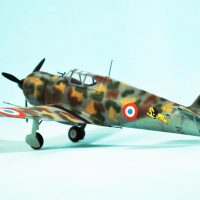








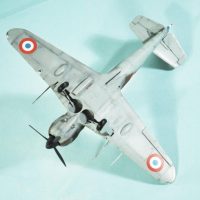








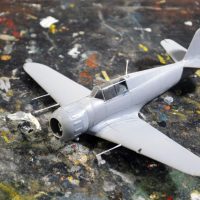




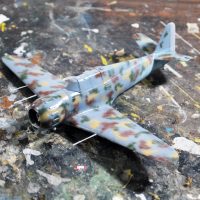



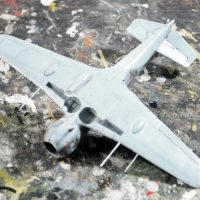


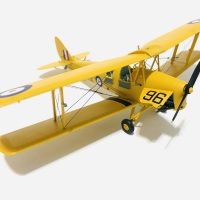
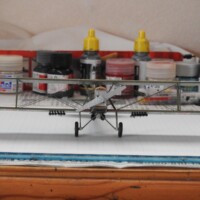
Another excellent model, @tcinla : super quick, superbly built and schemed!
Love the camo choice, indeed I was not aware that such mottled camo existed for the MB, only the "standard" one (which, by the way, was not standardized at all - just freehanded to the paiinter's apetite, or something like that 🙂 ).
Loved the "historical" part: it practically covers all aspects of this unsuccesful, but nevertheless important aircraft . Only "downside" (personally), is that I will REALLY have to dig into every bit of HAF history, in order to add an "original" historical part on my presentation article, upon building my HAF MB 🙂
I'm certain you'll find some obscure something, @fiveten. 🙂
Turned out great! Good camo choice, something a bit out of the ordinary.
At the moment, my dad builds the same kit, not 100% decided which scheme he schould do.
Make sure you point out the review to him so he can avoid the minefields.
An amazing result on this MB, Tom @tcinla
This scheme is awesome and you did an extreme good job to apply it.
Very nice Tom, great looking MB152. Love the camo scheme.
You know, I only realized within the last year or so that 'Pre-War' Bloch was actually 'Post-War' Dassault.
Looks great, nicely done scheme!
Nice review and history Tom. Thank you.
It is said that France was the strongest military force in Western Europe before the war but political bickering made them not be ready for what was to come. Same a bit all over Europe besides Britain that did get it together in time... beIng on island did help Them too !
Gnome-Rhone engines were captured In great numbers to feed the Luftwaffe shortages in airplane engines. One loses, one gains. Is it not always so.
Nice kit.
I like it - and like the camo really well - I hadn't seen French camo with that lighter tan color in it. I just checked, and I've got that old 1/72 kit in the stash - and now I have a good reference!
Nice build of a plane I really knew nothing about until reading your article. Great camo scheme, I don't know how effective it would have been over France but proves to be very effective over your work bench 😉 . Nice work really though, limited runs, even good ones can be a challenge.
"A neat desk is the sign of a sick mind." 🙂
That explains a lot : no work happening.
Now you are a Blochhead. Looks great. Dora is coming out wth some neato stuff. I tink a P-66 is on the way.
A P-66, an AT-9 "jeep", a Vultee Vengeance, two different sub-types of Lockheed Vega.
Thinking of doing the other Lockheed "Stars," the Altair and Orion.
The camo is exceptional, Tom (@tcinla). Great model of a plane you don't see very much.
Looks good Tom. I'm working on their J9/P-35 now. You also need your limited run building skills with this one.
Check my post in the WIP Group.